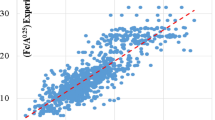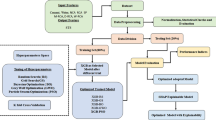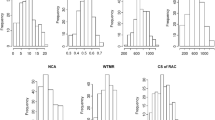Abstract
As concerns on environmental issues are consistently escalating in the perspective of establishing sustainable and environmental-friendly construction in the construction industry, one prominent approach to address this agenda is the application of recycled aggregate concrete (RAC) to concrete production. However, this particular concrete possesses different physical and mechanical properties from those of normal concrete, raising the difficulty of proper understanding and implementation in real-world practice. Accordingly, these shortcomings have drawn the inspiration in this research to devote efforts in deriving an accurate formulation of RAC elastic modulus which is contemplated as one crucial problem relevant to RAC properties. Furthermore, this research proposed symbiotic polyhedron operation tree (SPOT) which incorporated Symbiotic Organisms Search 2.0 and polyhedron operation tree together to develop the prediction model. From result findings and several analyses conducted, the proposed model has shown superiority among other applied methods in terms of stability and robustness. SPOT provides the best RMSE, MAE, MAPE, R, and R2 values in testing data with major difference. Moreover, the final developed model of SPOT which is interpreted as the RAC elastic modulus equation consists of all input variables constructed in the equation. Hence, having the high accuracy and capability to construct relationship between RAC properties, this model conclusively demonstrated an auspicious capability in accomplishing the objectives specified in this research, especially within this research scope of RAC.











Similar content being viewed by others
References
Arezoumandi M (2017) Mechanical properties and structural performance of recycled aggregate concrete: an overview. Civ Eng Res J. https://doi.org/10.19080/cerj.2017.01.555571
Sadati S et al (2019) Artificial intelligence to investigate modulus of elasticity of recycled aggregate concrete. ACI Mater J 116(1):51–62. https://doi.org/10.14359/5170694
Reyes-sánchez JA et al (2018) Predicting modulus of elasticity of recycled aggregate concrete using nonlinear mathematical models. Int J Comput Methods Exp Meas 6(4):703–715. https://doi.org/10.2495/cmem-v6-n4-703-715
Choong WK et al (2013) Elastic modulus of concrete cast with recycled aggregates. Appl Mech Mater 423–426:1006–1009. https://doi.org/10.4028/www.scientific.net/amm.423-426.1006
Surahyo A (2019) Concrete construction: practical problems and solutions. Springer, Berlin. ISBN:978-3-030-10509-9 978-3-030-10510-5. https://doi.org/10.1007/978-3-030-10510-5
Kumar MP, Monteiro PJ (2014) Concrete—microstructure, properties, and materials, 4th edn. McGraw Hill Education, New York. ISBN-10: 0071797874. ISBN-13: 978-0071797870
Konrad Z, Frank R (2001) Design of concrete structures made from recycled aggregate—a globe recommendation following the DIN 1045-1. In: Proceeding to the fib-symposium concrete and environment, Berlin
Rasheeduzzafar KA (1984) Recycled concrete—a source of new aggregate. Cem Concr Aggreg 6(1):17–27. https://doi.org/10.1520/CCA10349J
Ravindrarajah RS, Tam CT (1985) Properties of concrete made with crushed concrete as coarse aggregate. Mag Concr Res 37(130):29–38
Tavakoli M, Soroushian P (1996) Strength of recycled aggregate concrete made using field-demolished concrete as aggregate. ACI Mater J 93(2):182–190. https://doi.org/10.14359/9802
Xiao JZ, Li JB, Zhang C (2006) On relationships between the mechanical properties of recycled aggregate concrete: an overview. Mater Struct 39(290):655–664. https://doi.org/10.1617/s11527-006-9093-0
Duan ZH, Kou SC, Poon CS (2013) Using artificial neural networks for predicting the elastic modulus of recycled aggregate concrete. Constr Build Mater 44:524–532. https://doi.org/10.1016/j.conbuildmat.2013.02.064
Behnood A, Olek J, Glinicki MA (2015) Predicting compressive strength of recycled aggregate using M5′ model. In: Proceeding of international symposium, Brittle Matrix Composites 11. Institute of Fundamental Technological Research
Golafshani EM, Behnood A (2018) Automatic regression methods for formulation of elastic modulus of recycled aggregate concrete. Appl Soft Comput J 64:377–400. https://doi.org/10.1016/j.asoc.2017.12.030
Cheng MY, Firdausi PM, Prayogo D (2014) High-performance concrete compressive strength prediction using Genetic Weighted Pyramid Operation Tree (GWPOT). Eng Appl Artif Intell 29:104–113. https://doi.org/10.1016/j.engappai.2013.11.014
Bhardwaj S et al (2016) Use of recycled concrete aggregate in costruction. Int J Emerg Technol Eng Res IJETER 4(10):81–87. https://doi.org/10.1007/bf02480538
Kou SC, Poon CS, Chan D (2017) Influence of fly ash as cement replacement on the properties of recycled aggregate concrete. J Mater Civ Eng 19(9):709–717. https://doi.org/10.15680/ijirset.2015.0406113
McGovern M (2002) Going with the flow, in concrete technology today. Portland Cement Association
Corinaldesi V (2010) Mechanical and elastic behaviour of concretes made of recycled-concrete coarse aggregates. Constr Build Mater 24(9):1616–1620. https://doi.org/10.1016/j.conbuildmat.2010.02.031
Dhir RK, Limbachiya MC, Leelawat T (1999) Suitability of recycled aggregate for use in BS 5328 designated mixes. Proc Inst Civ Eng Struct Build 134(3):257–274. https://doi.org/10.1680/istbu.1999.31568
Dillmann R (1998) Concrete with recycled concrete aggregate. In: Proceedings of international symposium on sustainable construction: use of recycled concrete aggregate. https://doi.org/10.1680/scuorca.27268.0021
Kakizaki M et al (1988). Strength and elastic modulus of recycled aggregate concrete. In: Proceedings of the second international RILEM symposium on demolition and reuse of concrete and masonry
Mellmann G, Meinhold U, Maultzsch M (1999) Processed concrete rubble for the reuse as aggregates. In: Exploiting wastes in concrete. Thomas Telford Publishing, pp 171–178. ISBN: 978-0-7277-4724-2. https://doi.org/10.1680/ewic.28210.0016
Zilch K, Roos F (2001) An equation to estimate the modulus of elasticity of concrete with recycled aggregates. Civ Eng 76(4):187–191
Melo V, Banzhaf W (2016) Kaizen programming for feature construction for classification. pp 39–57. ISBN: 978-3-319-34221-4. https://doi.org/10.1007/978-3-319-34223-8_3
Fazel Zarandi MH et al (2008) Fuzzy polynomial neural networks for approximation of the compressive strength of concrete. Appl Soft Comput J 8(1):488–498. https://doi.org/10.1016/j.asoc.2007.02.010
Pham A-D, Hoang N-D, Nguyen Q-T (2015) Predicting compressive strength of high-performance concrete using metaheuristic-optimized least squares support vector regression. J Comput Civ Eng 30(3):06015002. https://doi.org/10.1061/(asce)cp.1943-5487.0000506
Khazaee A, Ghalehnovi M (2018) Bearing stiffness of UHPC; an experimental investigation and a comparative study of regression and SVR-ABC models. J Adv Concr Technol 16(3):145–158. https://doi.org/10.3151/jact.16.145
Prayogo D, Wong FT, Tjandra D (2018) Prediction of high-performance concrete strength using a hybrid artificial intelligence approach. MATEC Web Conf 203:06006. https://doi.org/10.1051/matecconf/201820306006
Yu Y et al (2018) A novel optimised self-learning method for compressive strength prediction of high performance concrete. Constr Build Mater 184:229–247. https://doi.org/10.1016/j.conbuildmat.2018.06.219
Bui DK et al (2018) A modified firefly algorithm-artificial neural network expert system for predicting compressive and tensile strength of high-performance concrete. Constr Build Mater 180:320–333. https://doi.org/10.1016/j.conbuildmat.2018.05.201
Behnood A, Olek J, Glinicki MA (2015) Predicting modulus elasticity of recycled aggregate concrete using M5′ model tree algorithm. Constr Build Mater 94:137–147. https://doi.org/10.1016/j.conbuildmat.2015.06.055
Golafshani EM, Behnood A (2018) Application of soft computing methods for predicting the elastic modulus of recycled aggregate concrete. J Clean Prod 176:1163–1176. https://doi.org/10.1016/j.jclepro.2017.11.186
Peng CH, Yeh IC, Lien L-C (2009) Building strength models for high-performance concrete at different ages using genetic operation trees, nonlinear regression and neural networks. Eng Comput 26(1):61–73. https://doi.org/10.1007/s00366-009-0142-5
Tsai HC (2011) Weighted operation structures to program strengths of concrete-typed specimens using genetic algorithm. Expert Syst Appl 38(1):161–168. https://doi.org/10.1016/j.eswa.2010.06.034
Cheng MY, Prayogo D (2014) Symbiotic organisms search: a new metaheuristic optimization algorithm. Comput Struct 139:98–112. https://doi.org/10.1016/j.compstruc.2014.03.007
Bhattacharya A, Chatoopadhyay PK (2010) Hybrid differential evolution with biogeography-based optimization for solution of economic load dispatch. IEEE Trans Power Syst 25:1955–1964. https://doi.org/10.1109/tpwrs.2010.2043270
Du D, Simon D, Ergezer M (2009) Biogeography-based optimization combined with evolutionary strategy and immigration refusal. IEEE Press, Piscataway. https://doi.org/10.1109/icsmc.2009.5346055
Gong W, Cai Z, Ling CX (2011) DE/BBO: a hybrid differential evolution with biogeography-based optimization for global numerical optimization. Soft Comput 15(4):645–665. https://doi.org/10.1007/s00500-010-0591-1
Jothiprakash V, Arunkumar R (2013) Optimization of hydropower reservoir using evolutionary algorithms coupled with chaos. Water Resour Manag 27(7):1963–1979. https://doi.org/10.1007/s11269-013-0265-8
Saremi S, Mirjalili SM, Mirjalili S (2012) Chaotic krill herd optimization algorithm. Proc Technol 12:180–185. https://doi.org/10.1016/j.protcy.2013.12.473
Simon D (2008) Biogeography-based optimization. IEEE Trans Evolut Comput 12(6):702–713. https://doi.org/10.1109/tevc.2008.919004
Wang GG et al (2014) Chaotic krill herd algorithm. Inf Sci 274:17–34. https://doi.org/10.1016/j.ins.2014.02.123
Wang N, Liu L, Liu L (2001) Genetic algorithm in chaos. OR Trans 5(3):1–10
Yang LJ, Chen TL (2002) Application of chaos in genetic algorithms. Commun Theor Phys 38(2):168–172. https://doi.org/10.1088/0253-6102/38/2/168
Zhenyu G et al (2006) Self-adaptive chaos differential evolution. Adv Nat Comput 1:972–975
Author information
Authors and Affiliations
Corresponding author
Ethics declarations
Conflict of interest
The authors declare that there is no conflict of interest for this article publication.
Ethical approval
This article does not contain any studies with human participants or animals performed by any of the authors.
Additional information
Publisher's Note
Springer Nature remains neutral with regard to jurisdictional claims in published maps and institutional affiliations.
Rights and permissions
About this article
Cite this article
Cheng, MY., Gosno, R.A. Symbiotic polyhedron operation tree (SPOT) for elastic modulus formulation of recycled aggregate concrete. Engineering with Computers 37, 3205–3220 (2021). https://doi.org/10.1007/s00366-020-00988-y
Received:
Accepted:
Published:
Issue Date:
DOI: https://doi.org/10.1007/s00366-020-00988-y




